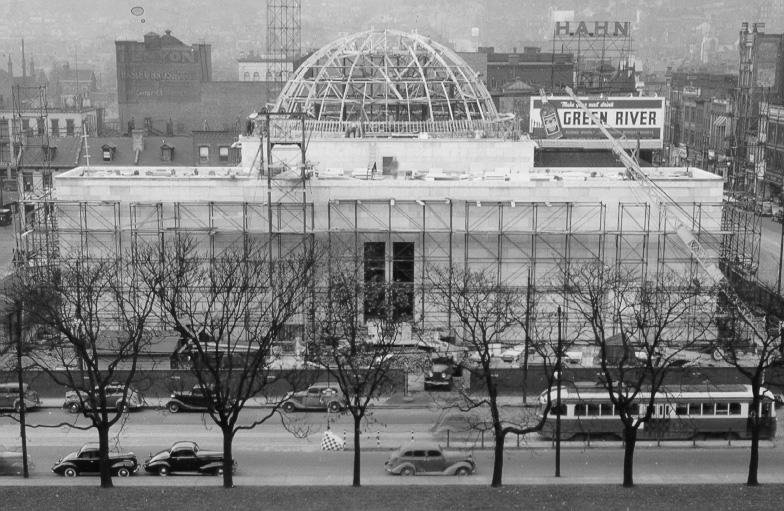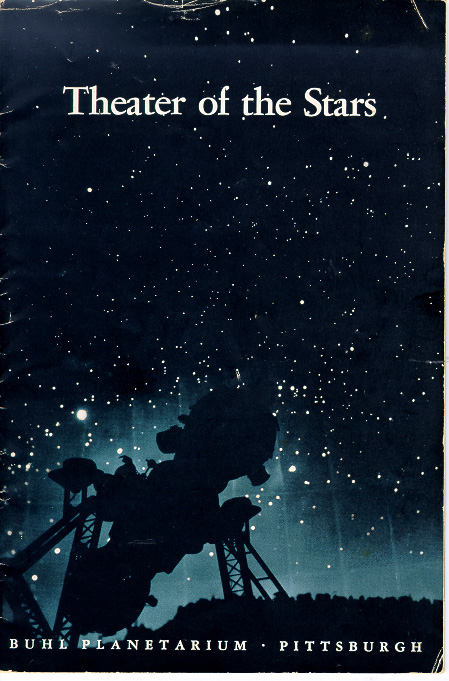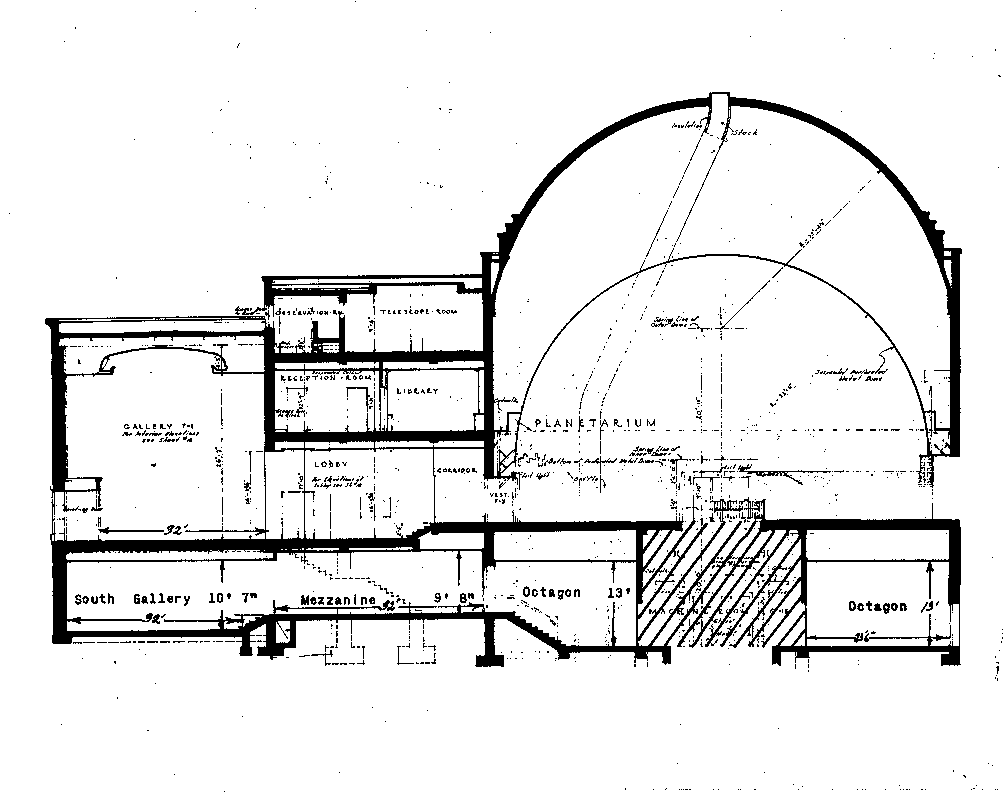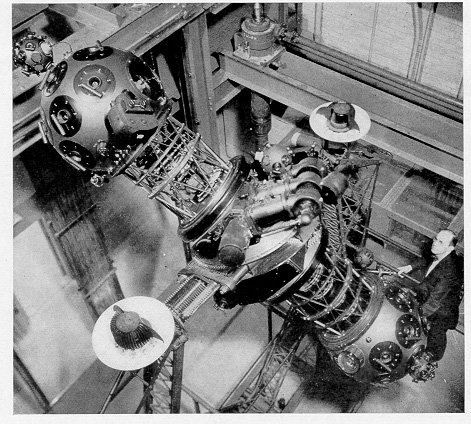Dome Construction of
The Buhl Planetarium and Institute of Popular Science, Pittsburgh
Autumn, 1938

Photograph shows progress on the construction of building and dome of Pittsburgh's
Buhl
Planetarium and Institute of Popular Science, on October 22, 1938 (a year before
the building
opened to the public). This photograph was taken from the roof of the
Boggs and Buhl Department Store (razed in the 1960s}, one block south
(on the other side of Ober Park, renovated by the city at the same time as construction
of Buhl Planetarium) of The Buhl Planetarium and Institute of Popular Science.
Internet Address for this Web Page:
https://buhlplanetarium4.tripod.com/Buhldome.html
Internet Address for Cover Page of the
History of The Buhl Planetarium and Institute of Popular Science, Pittsburgh:
http://www.planetarium.cc
Electronic Mail: dome@planetarium.cc
The Buhl Planetarium and Institute of Popular Science was constructed, between 1937
and 1939, on the Lower
North Side of Pittsburgh in what once was the central business district of
Pittsburgh's "sister city," the
City of Allegheny. In fact, the Buhl Planetarium building was built in
Diamond Square, on the former site of the
Allegheny City Hall.
Just west of the Buhl Planetarium
building is another domed building which formerly housed the main
Post Office of Allegheny
City; this building, finished in 1897, is now used by the Pittsburgh
Children's Museum. Just east of the Buhl Planetarium building is the 1890 building which
houses the first publicly funded Carnegie Library and the very first Carnegie Hall in
the world(New York City's
Carnegie Hall did not open until more than a year later!). This
Library continues to be used as the
Allegheny Regional Branch of
The Carnegie Library of Pittsburgh; Carnegie Hall has been
modified and now holds the
Hazlett Theatre. Three other well-known buildings in the area, which were razed,
include the
Allegheny Market House and Boggs and Buhl Department Store in Diamond Square and the
Federal Street or "Fort Wayne" Station of the Pennsylvania Railroad a block further
south. About the same time Buhl Planetarium was constructed,
Diamond Square
was transformed into
Ober Park; with the urban renewal of the 1960s, and the construction of
Allegheny Center, this park was transformed again in the
Allegheny Square Plaza[which, once
again, has a fountain--now, in the center of a small amphitheater].
At the urging of the Amateur Astronomers' Association
of Pittsburgh, Pittsburgh's Buhl Foundation[then the thirteenth largest foundation in the
country] agreed to construct a planetarium for Pittsburgh in 1935. A
lease agreement,
between the Buhl Foundation and the
City of Pittsburgh, for
construction of this new
institution was signed on July 20, 1937;
demolition of the Allegheny City Hall occurred in
the Autumn of 1937 with
construction of the new building beginning in the Spring of 1938. Cornelius Scully,
Mayor of the City of Pittsburgh, and other public officials participated in the official
groundbreaking for Buhl Planetarium on April 14, 1938.
Of course, this event was covered by Pittsburgh newspapers and radio stations. Dave
Garroway, who went on to be the first host of NBC-TV's "Today Show" in the 1950s,
covered this event for Pittsburgh's
KDKA Radio[the
nation's first commercial radio station
which had started by broadcasting the Harding--Cox U.S. Presidential Election Returns on
November 2, 1920].


The exterior dome of
The Buhl Planetarium and Institute of Popular Science, Pittsburgh,
as it appeared in October of 1939(first photograph) and October of 1998(second photograph).
The architect for
The Buhl Planetarium and Institute of Popular Science was
Ingham and Boyd
and the general contractor was the W.F. Trimble and Sons Company.
Construction of Buhl Planetarium's exterior dome began on October 11, 1938. This dome was
erected by the R. Guastavino Company.
Located at 500 Fifth Avenue in New York City, the R. Guastavino Company was owned in 1938 by
Rafael Guastavino, son of the company's founder who had the same exact name; the founder died in 1908. This
company is well-known for their work on
New York City's first subway called the IRT[
Interborough Rapid Transit], particularly for the elegant series of timbrel vaults,
known as the Guastavino Arch, in the
City Hall Subway Station, which opened in 1904. Regrettably, this particular subway
station has been closed to the public since December 31, 1945, but the
Lexington Avenue local (#6) subway train still uses the loop track[where this subway
station is located] to turn around.
 The R. Guastavino Company's Construction Superintendent, for the erection of Buhl
Planetarium's exterior dome, was Frank Tisdale Bretherton(pictured to the left, circa 1914).
Frank Bretherton immigrated to the United States from
England in 1908, at age 24. During his career with the
R. Guastavino Company, Frank Bretherton supervised many
construction projects between 1915 and 1939; he died in 1941.
The R. Guastavino Company's Construction Superintendent, for the erection of Buhl
Planetarium's exterior dome, was Frank Tisdale Bretherton(pictured to the left, circa 1914).
Frank Bretherton immigrated to the United States from
England in 1908, at age 24. During his career with the
R. Guastavino Company, Frank Bretherton supervised many
construction projects between 1915 and 1939; he died in 1941.
Frank Bretherton married Mildred(Millie) Taylor Bretherton in New York on
December 12, 1913. Frank and
Millie Bretherton had two children, Lionel Tisdale Bretherton born September 22, 1914 and
Ralph Aston Bretherton born August 3, 1916.
Click here to see a portrait of the young couple, taken in Manchester, England
in early 1914, while visiting family shortly after their wedding.
Millie Bretherton died during a flu
epidemic in 1918. More than 21 million people died world-wide, 600,000 in the United States,
during the 1918 flu epidemic. In some cases this flu epidemic devastated entire towns, such
as the Pittsburgh suburb of
Munhall, home of the
Homestead Steel Works of the
United States Steel Corporation[formerly the
Carnegie Steel Company Limited].
Several other projects in the Pittsburgh area included construction
supervised by Frank Bretherton,
for the R. Guastavino Company:
U.S. Post Office and Courts Building
on Grant Street[also,
see this link],
City-County Building,
Heinz Memorial Chapel[next to the 42-story
Cathedral of Learning on the campus of the
University of Pittsburgh], A.W. Mellon residence,
and one or more buildings of the Carnegie Institute of Technology[now
Carnegie
Mellon University]. The construction of other buildings, which included
projects supervised by Mr.
Bretherton for the R. Guastavino Company, include the
Supreme Court of the United States and the
Washington
National Cathedral in Washington, D.C.;
the
Thomas Jefferson University Hospital in Philadephia;
Buffalo City Hall;
Princeton University Chapel;
Duke University Chapel;
West Point Military Academy Gymnasium;
Bellevue Hospital,
Western Union Building, and
The Cathedral Church of St. John the Divine[World's Largest Cathedral!] in New York
City; and
numerous other projects in
New York and New Jersey.
During construction of this dome, in the Autumn of 1938, Frank Bretherton
wrote a
series of letters[sixteen known letters] to the R. Guastavino Company[most letters addressed to
Mr. Guastavino] regarding the progress and problems associated
with the dome's construction.
 Nan Cattell, granddaughter of Frank Bretherton, found the
carbon copies of these sixteen letters
[maintained by Frank Bretherton] in April of 2001,
among the personal effects of her father,
Ralph Aston Bretherton, after her father passed
away.
Nan Cattell, granddaughter of Frank Bretherton, found the
carbon copies of these sixteen letters
[maintained by Frank Bretherton] in April of 2001,
among the personal effects of her father,
Ralph Aston Bretherton, after her father passed
away.
Ms. Cattell graciously provided the carbon copies of these letters for inclusion in
the History of The Buhl Planetarium and Institute of
Popular Science Internet web site.
Links are provided, to each one of these
letter carbon copies.
Following the completion of this section of the web
site, a CD-ROM containing images of all of these
letter carbon copies were donated, for preservation, to the
Library and Archives of the
Historical Society of Western Pennsylvania at the
Senator John Heinz Pittsburgh Regional History Center.
All of
Frank Bretherton's letters were handwritten; apparently, typewriters were not
commonly found on construction sites, in this era.
The
letter carbon copies were maintained by Frank Bretherton in a "Standard
Correspondence Book" bound message pad. This message pad included blank pages, which Frank
Bretherton used to record the carbon copy of each letter and lined pages[only lined on the
front; blank on the back]. The blank and lined pages alternated throughout the message
pad. Each original letter[sent to New York] was written on the lined sheets, while the
message was carbon-copied on the blank sheets; a blue piece of carbon paper is included
with this message pad.
All of the scanned images were enlarged to ensure readability, since the carbon copies
are old, and all are handwritten. Due to this enlargement, these are large JPEG image
files; as such, each page may take some time to load on older model computers and computers
using telephone modems. Also, a few of the scanned images of the carbon copies are
very light and difficult to read. For these reasons, all pages of the letter carbon copies
are transcribed on a
HTML page, which should load fairly quickly. Both the
carbon copy of
each page, and the
transcription of each page, are included on this Internet web site.
One interesting anecdote regarding this
business correspondence: both the erection of the
Buhl Planetarium dome and the delivery of the U.S. Mail, apparently, continued on normal
schedules on Friday, November 11, 1938. In the
November 11 letter, Frank Bretherton begins by
acknowledging the receipt of
Mr. Guastavino's letter of November 10: "I have your letter of yesterday the
10th." Although November 11 would have commemorated the twentieth anniversary of the
Armistice of World War I, it seems that work continued in the strong labor city of
Pittsburgh, as
did postal deliveries.
And, it is fascinating to think that it only took one day for a
letter to arrive in Pittsburgh, from New York City, in 1938; today, such delivery usually
takes two days. Air Mail delivery was probably used for this one-day service; however
today, nearly all long-distance mail goes by air. To receive one-day delivery service
today, between New York and Pittsburgh, an express service from the U.S. Postal Service,
or one of the private courier services, would have to be employed. The cost differential,
between First Class Mail and the express service is much greater today, than the cost
differential between First Class Mail and Air Mail in
1938.
Buhl's exterior dome is composed of tile, covered with copper; this dome has a diameter
of 72 feet. When
The Buhl Planetarium and Institute of Popular Science was dedicated, on October 24,
1939, the copper-clad exterior dome had a shiny appearance.
Weathering of the copper, over
the years, has led to the green dome we see today.
 It must be remembered that the exterior dome, which most people are familiar with, is not
the dome used to actually show the stars of the night sky in
Buhl's Planetarium Theater.
A 65-foot diameter stainless steel inner dome is provided, in the
Theater of the Stars,
as the projection screen for Buhl's
Zeiss II Planetarium Projector; the top of this interior dome is 42 feet above the
floor of the
Planetarium Theater. The
15-foot gap
between the exterior and interior domes is needed for the Theater's sound system, electrical
wiring, the ventilation, heating and air conditioning systems, as well as the work lights
and emergency lights.
It must be remembered that the exterior dome, which most people are familiar with, is not
the dome used to actually show the stars of the night sky in
Buhl's Planetarium Theater.
A 65-foot diameter stainless steel inner dome is provided, in the
Theater of the Stars,
as the projection screen for Buhl's
Zeiss II Planetarium Projector; the top of this interior dome is 42 feet above the
floor of the
Planetarium Theater. The
15-foot gap
between the exterior and interior domes is needed for the Theater's sound system, electrical
wiring, the ventilation, heating and air conditioning systems, as well as the work lights
and emergency lights.
Although it looks solid, the interior dome is actually composed of thousands of tiny holes;
without these holes, the
Theater of the Stars would be a large echo chamber!
The 15-foot gap
between the exterior and interior domes also allows for acoustic padding, to prevent the
outer dome from giving an echo effect. Of course, placing acoustic padding on the inside
of the interior dome[if this was the only dome which existed] would not permit the proper
display of the stars and other celestial bodies on the dome.
The thousands of holes
also allow for proper ventilation of the Theater. In addition to projecting the stars and
other images onto the interior dome, three-dimensional objects can be lighted from directly
behind the inner dome for viewing by the planetarium show audience.
At the beginning of Buhl Planetarium performances, called "sky shows," the lecturer would often turn on
the work lights behind the interior dome, to show the audience how transparent the
interior dome really is.
The creche displayed during
the seasonal show, "The Star of Bethlehem," was a three-dimensional nativity
scene illuminated from just behind the interior dome. In some years called
"The Christmas Star," this audience favorite has been shown every Christmas season since
the Buhl Planetarium opened in 1939. This show continues to be presented each holiday season
in the
Henry Buhl, Jr. Planetarium at Pittsburgh's
Carnegie Science Center.
Also remember that, unlike the domes at the
Valley View Observatory[first observatory in the world with an all-aluminum dome!(1930)
--to be
restored, in the next few years, by the
Amateur Astronomers' Association of Pittsburgh],
Allegheny Observatory[of the
University of Pittsburgh, located on a high hill,
three miles north of Buhl Planetarium], or other major astronomical
observatories, neither the exterior nor interior domes of Buhl Planetarium actually open to the sky. Observatory
domes open so the telescope can view celestial objects in the sky. An accurate and
realistic depiction of the night sky is
projected by the
Zeiss II Planetarium Projector onto the interior dome of Buhl Planetarium's
Theater of the Stars, rain-or-shine!
Buhl Planetarium's
Zeiss II Planetarium Projector is now the oldest operable, major
planetarium projector in the world! All other major planetarium projectors,
now in operation, are younger
than Pittsburgh's 1938 gem! As a mechanical/optical instrument from the dawn of the
age of projection planetaria, Buhl's
Zeiss II was specifically designed to project images
of the stars, and other celetial objects, onto the 65-foot
diameter inner dome in Buhl's
Theater of the Stars. And, although the newer computerized
planetarium projectors have advanced capabilities, the "star picture"[the contrast between
the stars and the darkness of space] presented by the
Zeiss II is unsurpassed by any other
projector.

This photograph shows Buhl Planetarium's
Zeiss II Planetarium Projector in the
elevator pit,
below the
Theater of the Stars. Buhl's projector was the first planetarium
projector in the world
to be placed on an elevator--a fairly unique "worm-gear" elevator
produced by the
Westinghouse Electric Corporation.
Internet Web Site Master Index for
the History of
The Buhl Planetarium and Institute of Popular Science,
Pittsburgh
Other Internet Web Sites of Interest
History of The Buhl Planetarium and
Institute of Popular Science, Pittsburgh
Including the oldest operable, major planetarium projector in the world !
History of the Adler Planetarium and
Astronomy Museum, Chicago
America's First Major Planetarium !
History of Astronomer, Educator, and
Optician John A. Brashear
Friend of Andrew Carnegie
History of Andrew Carnegie and Carnegie
Libraries
History of The Duquesne
Incline, Pittsburgh
Historic Cable Car Railway Serving Commuters and Tourists since 1877 !
Antique Telescope Society
And, information regarding the Society's
September, 2001 Convention
in Pittsburgh.
Other
History Links
Disclaimer Statement: This Internet web page is not affiliated with
the
Henry Buhl, Jr.
Planetarium and Observatory,
The
Carnegie Science
Center, or The
Carnegie Museums of Pittsburgh/Carnegie Institute.
This Internet, World Wide Web Site administered by Glenn A.
Walsh.
Unless otherwise indicated, all web pages in this web site are © Copyright
2001,
Glenn A. Walsh, All Rights Reserved.
Additions and corrections to:
dome@planetarium.cc
 The R. Guastavino Company's Construction Superintendent, for the erection of Buhl
Planetarium's exterior dome, was Frank Tisdale Bretherton(pictured to the left, circa 1914).
Frank Bretherton immigrated to the United States from
England in 1908, at age 24. During his career with the
R. Guastavino Company, Frank Bretherton supervised many
construction projects between 1915 and 1939; he died in 1941.
The R. Guastavino Company's Construction Superintendent, for the erection of Buhl
Planetarium's exterior dome, was Frank Tisdale Bretherton(pictured to the left, circa 1914).
Frank Bretherton immigrated to the United States from
England in 1908, at age 24. During his career with the
R. Guastavino Company, Frank Bretherton supervised many
construction projects between 1915 and 1939; he died in 1941.